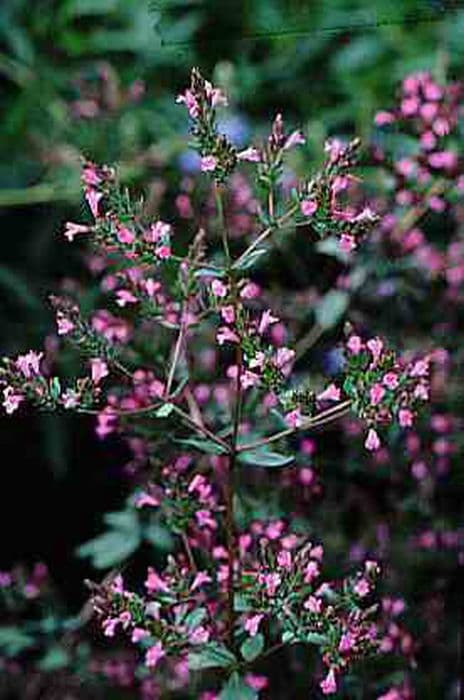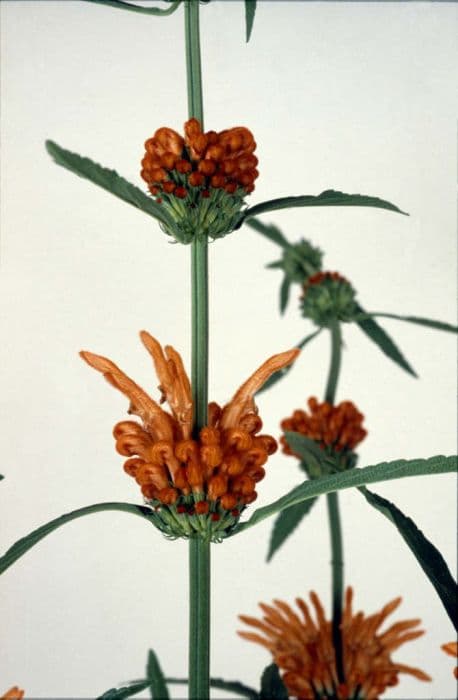Oregano Origanum laevigatum

ABOUT
Origanum laevigatum, commonly known as the ornamental oregano, is a perennial herb that is valued for its aromatic foliage and charming flowers. The plant typically sports a bushy growth habit, with branching stems that hold small, oval-shaped leaves. These leaves are often a gray-green hue and may have a slightly fuzzy texture, befitting many plants in the mint family, to which ornamental oregano belongs. The most striking feature of the ornamental oregano is its blooms. In the peak flowering season, clusters of tiny, tubular flowers appear, giving the impression of a cloud of color. These blossoms can range in hue from soft pinks to deep purples, sometimes with a hint of lavender, and are adept at attracting pollinators such as bees and butterflies. The flowers typically form in loosely arranged, terminal racemes, which create a delightful visual contrast against the backdrop of the foliage. Adding to the allure, the plant's stems can take on a reddish or purple tinge, which further enhances the overall presentation. This herb is often praised for its resilience and ease of growth, making it a popular choice in gardens where a splash of color and an inviting, aromatic atmosphere are desired.
About this plant
 Names
NamesFamily
Lamiaceae
Synonyms
Turkish Oregano, Hairy Oregano, Ornamental Oregano
Common names
Origanum vulgare subsp. laevigatum, Origanum vulgare var. laevigatum, Origanum virens.
 Toxicity
ToxicityTo humans
Origanum laevigatum, commonly known as the Hopley's Purple oregano, is not considered toxic to humans. As a member of the Lamiaceae family, it is often grown for culinary and ornamental use. However, ingesting any plant in large quantities could cause digestive discomfort due to fibers and oils that are not typically part of the human diet. But in the case of Hopley's Purple oregano, there are no well-documented cases of poisoning and no specific symptoms related to toxicity from this plant when consumed in usual amounts as a herb.
To pets
Hopley's Purple oregano is not typically listed as a toxic plant to pets, including cats and dogs. As with most herbs and plants, when consumed in small, culinary amounts, it is generally not harmful. However, if a pet were to consume a large amount of the plant, they might experience mild gastrointestinal upset, such as nausea or diarrhea. This is a common reaction in animals who eat plant matter that they are not accustomed to. There are no specific toxic principles in Hopley's Purple oregano that are known to cause serious harm or specific symptoms of poisoning in pets.
 Characteristics
CharacteristicsLife cycle
Perennials
Foliage type
Semi-deciduous
Color of leaves
Green
Flower color
Purple
Height
1-2 feet (30-60 cm)
Spread
1-2 feet (30-60 cm)
Plant type
Herb
Hardiness zones
7
Native area
Mediterranean
Benefits
 General Benefits
General Benefits- Culinary Uses: Origanum laevigatum, commonly known as marjoram, can be used to flavor various dishes, especially in Mediterranean cuisine.
- Aesthetic Appeal: With its purple flowers and fragrant foliage, marjoram can beautify gardens and landscapes.
- Attracts Pollinators: The flowers of marjoram are attractive to bees, butterflies, and other beneficial insects that are essential for pollination.
- Drought Resistance: Marjoram is drought-tolerant once established, making it suitable for xeriscaping and low-water gardens.
- Herb Gardening: Marjoram is a popular choice for herb gardens due to its versatility and ease of growth.
- Culinary Companion Planting: When grown alongside vegetables and other herbs, marjoram can enhance the growth and flavor of various plants.
- Low Maintenance: Marjoram is relatively easy to care for and does not require excessive watering or fertilizing once established.
 Medical Properties
Medical Properties- Antibacterial: Origanum laevigatum essential oil has been found to have antibacterial properties against a range of bacteria.
- Antifungal: The plant exhibits antifungal activity, particularly effective against Candida species.
- Antioxidant: The phenolic compounds present in Origanum laevigatum confer antioxidant benefits, helping to neutralize free radicals.
- Anti-inflammatory: It may have anti-inflammatory effects, potentially useful in alleviating inflammatory conditions.
- Antispasmodic: This plant has been used for its antispasmodic properties, which help in relieving spasms in the muscles.
 Air-purifying Qualities
Air-purifying QualitiesThis plant is not specifically known for air purifying qualities.
 Other Uses
Other Uses- Culinary Flavoring: The leaves of Origanum laevigatum, also known as marjoram, can be used to imbue dishes with a unique flavor, often added to recipes like soups, sauces, and marinades for meats.
- Aromatic Oil: Essential oil can be extracted from marjoram which is utilized in aromatherapy for its calming scent and is also used in making perfumes and scented candles.
- Natural Preservative: Marjoram has natural preservative properties and can be included in the preparation of certain foods to extend their shelf life.
- Decorative Uses: The attractive foliage and flowers of marjoram can be incorporated into flower arrangements and bouquets for decorative purposes.
- Garden Companion Planting: Marjoram can be planted alongside other garden crops such as vegetables to enhance growth and deter pests thanks to its strong scent.
- Dye Production: The plant can be used to produce a natural dye for fabrics, imparting a beige or light green color depending on the mordant used.
- Culinary Garnish: Fresh or dried marjoram leaves can be utilized as a garnish to add a touch of elegance and flavor to various culinary dishes.
- Organic Pest Control: The aromatic properties of marjoram can repel certain insects, making it a useful addition to organic pest control strategies in gardens.
- Herbal Baths: Leaves and flowers of marjoram can be added to bathwater for a fragrant and relaxing soak.
- Flavoring for Beverages: Marjoram can be infused into teas or alcoholic beverages to contribute a subtle, herbaceous flavor note.
Interesting Facts
 Feng Shui
Feng ShuiThe plant Origanum laevigatum, commonly known as "Hopley's Purple" oregano, is not used in Feng Shui practice.
 Zodiac Sign Compitability
Zodiac Sign CompitabilityHopley's Purple oregano is not used in astrology practice.
 Plant Symbolism
Plant Symbolism- Peace: Origanum laevigatum, commonly known as Marjoram, is often associated with peace and tranquility because its soothing scent is believed to have calming properties.
- Happiness: Marjoram is also considered a symbol of happiness as it was traditionally used in wedding ceremonies and various rituals to bring joy and positive energy.
- Longevity: The hardy nature and perennial status of Marjoram can symbolize longevity and robust health, as the plant is known to survive and thrive for many years.
- Love: Linked to the traditions of the ancient Greeks and Romans, where it was believed to be an herb of Aphrodite/Venus, the goddess of love, Marjoram is a symbol of love and honor.
- Protection: Marjoram has been thought to offer spiritual protection from negativity and harm, and it has been used in various cultures to purify spaces and objects.
 Water
WaterThe Origanum laevigatum, commonly known as the Hopley's Purple oregano, prefers moderate watering, allowing the top inch of soil to dry out between waterings. In general, watering once a week with around 1 gallon per plant should suffice, depending on the climate and soil drainage. Overwatering can lead to root rot, so it's important to ensure the plant has well-draining soil. During the summer months, you may need to water more frequently to keep the soil consistently moist but not waterlogged. In winter, reduce watering as the plant's growth slows down.
 Light
LightHopley's Purple oregano thrives in full sun, receiving at least 6 to 8 hours of direct sunlight a day. The best spot for this plant would be in an area where it can enjoy unobstructed sunlight, such as a south-facing garden bed or a sunny windowsill if grown indoors. However, in extremely hot climates, some afternoon shade can help prevent scorching.
 Temperature
TemperatureHopley's Purple oregano does well in a range of temperatures but prefers a temperate climate. The ideal temperature range for this plant is between 60°F and 80°F. It can tolerate temperatures down to about 30°F, but it should be protected from frost. The plant will struggle in temperatures exceeding 90°F and may require some shade and extra water in these conditions.
 Pruning
PruningHopley's Purple oregano should be pruned to promote bushy growth and to prevent it from becoming leggy. The best time to prune is in the spring as new growth starts to appear. Remove around one-third of the plant's height, cutting just above a set of leaves to encourage branching. Regular trimming of the tips throughout the growing season can also encourage a denser form.
 Cleaning
CleaningAs needed
 Soil
SoilThe best soil mix for the plant commonly known as Hopley's Purple Oregano should be well-draining with a loamy to sandy composition. This mix can be achieved by combining two parts potting soil, one part coarse sand, and one part compost to ensure nutrient-richness and good drainage. The soil pH should ideally be within the neutral to slightly alkaline range, around 6.5 to 8.0.
 Repotting
RepottingHopley's Purple Oregano typically does not require frequent repotting. It should be repotted every two to three years, or when the plant outgrows its current container, to ensure the root system has sufficient space and the soil remains fertile and well-draining.
 Humidity & Misting
Humidity & MistingHopley's Purple Oregano prefers low to average humidity levels. As a Mediterranean herb, it is accustomed to drier climates, so the best humidity level for this plant would be between 30% to 50%. It is important to avoid overly humid environments which can lead to issues such as fungal infections.
 Suitable locations
Suitable locationsIndoor
Place in a sunny spot with well-draining soil and minimal watering.
Outdoor
Full sun, well-draining soil, tolerate dry and poor soils well.
Hardiness zone
7-10 USDA.
 Life cycle
Life cycleOriganum laevigatum, commonly known as hop marjoram, begins its life cycle as a seed, which after dispersal will germinate in favorable conditions of warm temperatures and moist soil. The seedling emerges and develops into a vegetative plant, forming a rosette of leaves as it matures. The plant experiences vegetative growth, producing strong stems and aromatic leaves characteristic to this herbaceous perennial. Once mature, hop marjoram produces small, purple flowers typically during the summer, which are attractive to bees and other pollinators. After pollination, these flowers develop into seed heads that release new seeds to complete the reproductive cycle. Throughout its life, hop marjoram enters a period of dormancy in the colder months, only to resume growth in the spring.
 Propogation
PropogationPropogation time
Spring to early summer
Propogation: The most popular method to propagate Origanum laevigatum, commonly known as 'Hopley's Purple' oregano, is through stem cuttings. This typically takes place in late spring or early summer when the plant's growth is most vigorous. You start by selecting a healthy, non-flowering stem and cutting a 4- to 6-inch (approximately 10 to 15 centimeters) portion from the parent plant. Strip the leaves from the bottom half of the cutting, and dip the cut end into a rooting hormone to encourage root growth. Then, plant the cutting in a well-draining soil mix, ensuring at least two sets of leaf nodes are buried where roots can develop. Keep the soil consistently moist but not soggy and place the pot in a warm, bright spot out of direct sunlight. Roots typically establish within a few weeks, after which the new plant can be gradually acclimatized to outdoor conditions if being moved from indoors.









